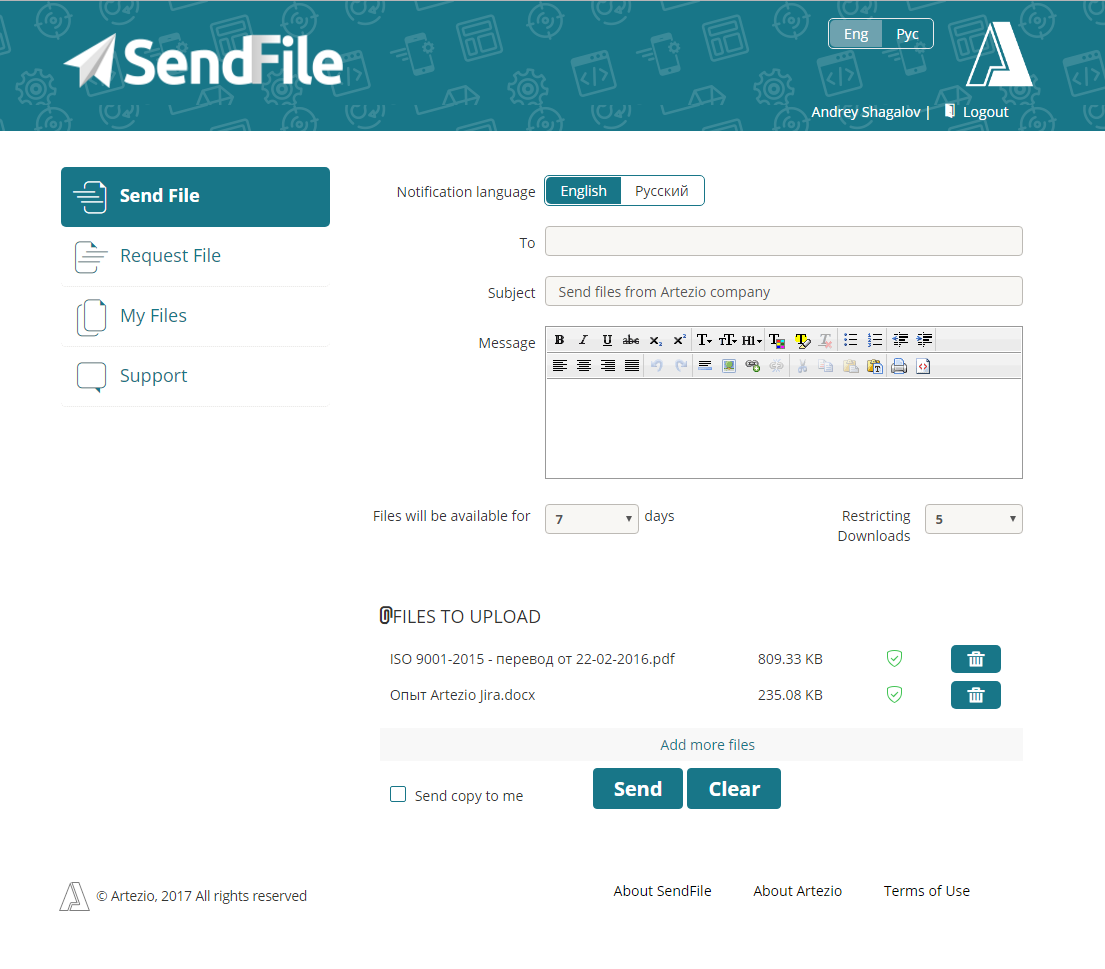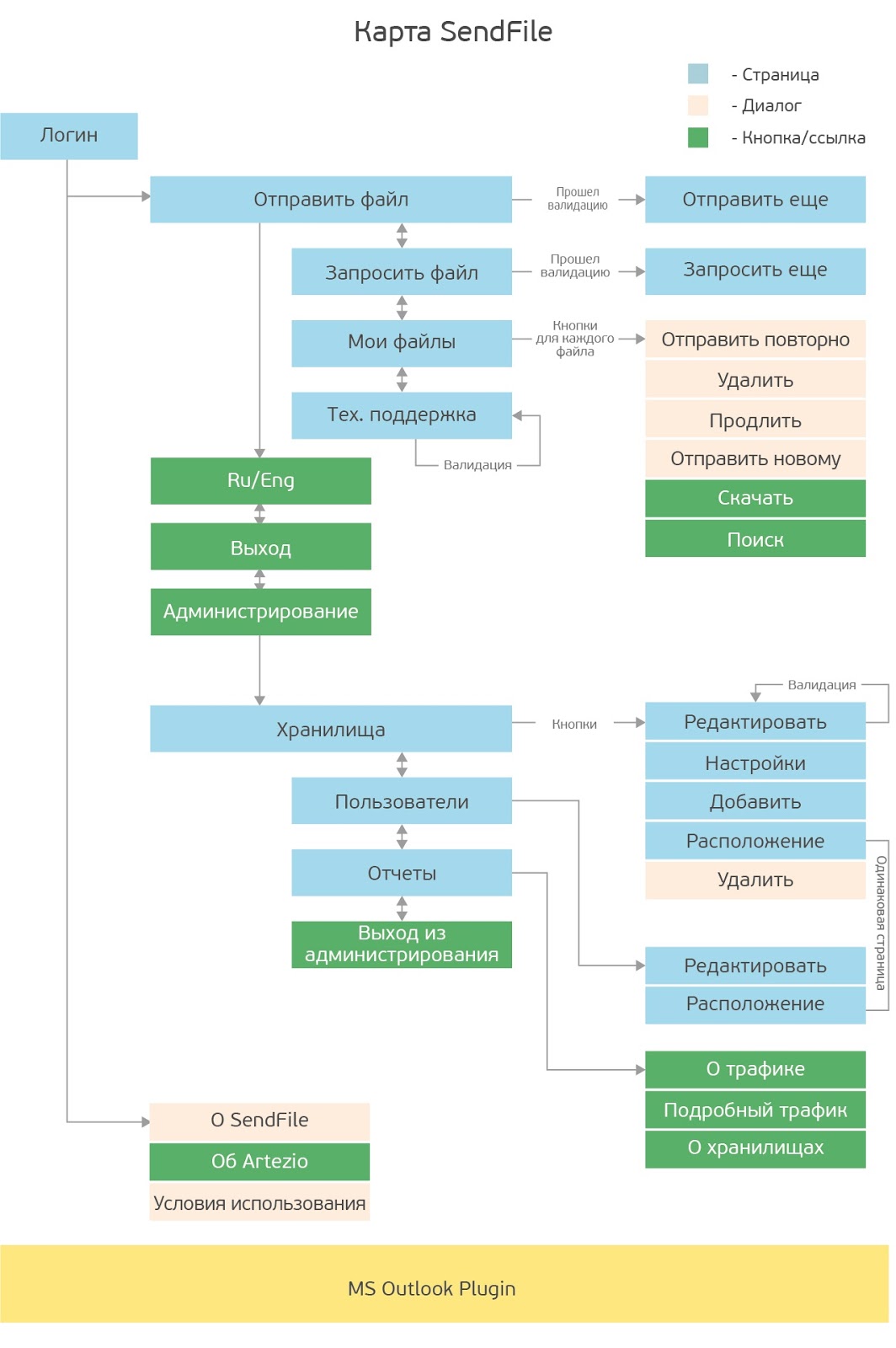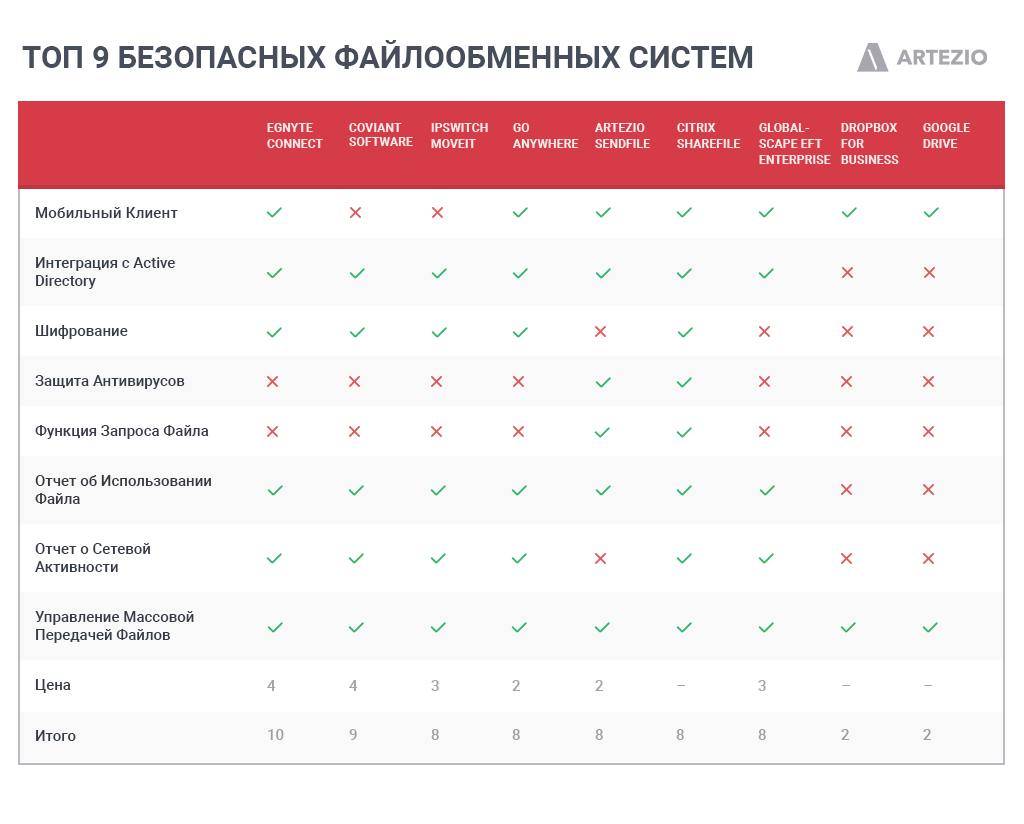How to create an alternative to Google Drive and Dropbox in 3700 hours
For 8 months of development, 3,700 working hours, Artezio team created its own file-sharing platform SendFile with 15 people. At first we considered it as an educational project, but then it outgrew this status. In this article I will tell you how it all began and what we have come to now.

Our company Artezio (LANIT group) is 16 years old, and we remember the times when customers had to send work on packages by parcels and custom-made packages. Imagine how hard it was for us and our customers to understand the heap of digital media! Then came the time of "slow Internet" and multi-volume archives that could be sent by email. But it is also not suitable if you need to send a large array of data. Even very liberal mail services will not allow this, and for this, there is no point in changing the settings of corporate mail.
 A source
A source
')
It remains to be used to share files with existing sites? But remember that five years ago it was the collapse of files on the Internet. It is dangerous and embarrassing to send a client for files to the hellish inferno of advertising, scripts. It is fair to say that there were decent cloud products. But a few years ago, when we thought about the file-sharing platform, they were still too expensive and unsafe. However, they remain so now. And that's why.
Even if all the content will be created directly in the cloud and transmitted through it, still a few questions will remain open. For example, security (separation of access for different users, access restriction on time, logging) or convenience of the interface for information distribution.
We conceived our product (it received the obvious name SendFile ) as a corporate application with a high level of security and integration with the company's internal infrastructure. In this regard, public services such as Google Drive, Yandex.disk or Dropmefiles are not of interest. For example, Google Drive is for anyone who uses Gmail. This solution is perfectly integrated with it. But this is also a weak point, because it requires a Google account, which is not always convenient in the case of commercial use.
During the development process, we were often asked: “Are you not afraid that you are creating a platform for piracy?” Especially often this question has come up since Russia has come to grips with torrents and other sites that distribute illegal content.
 A source
A source
To be honest, our file hosting service is suitable for sharing new movies and music. In the same way as a kitchen knife can become an instrument of crime. Any tool can be used both for good and for harm. But we have built in some security tools that can also be useful, if necessary, to help in the fight against illegal copying. For example, the system administrator knows who and when placed the specific file, who received it. You can define the types of files available for transfer in the system. You need to understand that our development is a corporate file sharing platform. It is unlikely that someone from corporate employees will count on complete anonymity if they begin to send movies and music to the office network. However, if you made a completely safe knife, it means that it does not cut.
The same goes for streaming. It may seem that file-sharing solutions are the last century. Like, now everything is decided by the technology of streaming data. But streaming involves the flow of data as a stream in parts. In this case, as a rule, you do not have a complete set of data at any time. This is really very useful when watching a video or listening to audio - no need to wait until the entire movie is downloaded. However, there is a lot of information for which integrity is important. That is, before you use the information, you must get it all. Request information from an incomplete database will lead to unpredictable and with a high probability erroneous result.
Imagine that you are "streaming" a text file. What do you see when you get only the first part of this file? You will not be able to read the text, you will not be able to edit it until the file transfer is complete. By analogy, "streaming" does not work with other types of files, including archives and data that developers transmit to their customers. To normally exchange data at a distance, you need a file sharing service.
People do not like to wait, so all successful services will try in various ways to provide the opportunity to work with them as quickly as possible, to hide the delay, to process it on the server-cloud side, to produce results in parts. But so far this is not always acceptable, and I do not think that the picture will fundamentally change in the next ten years.
From the very beginning, two students worked on the project who wanted to get a job in our company. This is very similar to the story of the emergence of a popular social network, which was born in a student dormitory. But with the file sharing turned out easier. In Artezio there is a Junior Lab training unit, and it allows recruits to stand out, to realize an idea that most likely will not go into circulation. Nobody expected that the student's work will live long and be developed. As a result, the spontaneous idea and grew into a commercial product.
It took 3,700 hours or 8 months of work to create a file-sharing project. (We do not consider the initial student development.) From this time, 64% was spent only on development, 20% on testing, 16% on management and analysis. During this time, 15 people participated in the project.
At different periods, the team changed. As the commercial potential grew, so did the team. Now the project does not need a lot of specialists. We have a finished product with a practical design, great potential.
The project was developed in two stages. As I already said, in the framework of the first - we created a working prototype with the help of Junior Lab interns (we still took them to work). The second stage was a promising refinement, adaptation for commercial projects.
The first prototypes of development were successful, and we began to use the product in our company. Moreover, the development was also liked by our colleagues from LANIT. Therefore, the file sharing system was also registered in their office as a corporate standard. Considering that LANIT is a group of companies with a team of several thousand people, our system has become an additional bridge between offices, ensuring the transfer of files between employees. This is convenient when the business is conducted by different companies that do not have access to a single corporate network. Of course, the system was actively used to send information to customers.
Then there was a commercial integration for a large Russian state-owned company, which demanded the ability to encrypt data. Unfortunately, I can not reveal all the details of the integration and name the customer. I can only say that we had to make specific changes that strengthened the security of file transfer and the identification of users. This project was the beginning of the state service for file sharing. He works on it so far.
We did not abandon the development of the project and developed its updated version. This second phase of development is almost over.
The first version looked like this.

And here is the updated version.

When creating the platform, we did not focus on any breakthrough technologies. Everything is pretty usual, if we consider the tools separately, and it is interesting when you look at the result.
We used the open source framework Spring. The multiplatform package Clam AntiVirus was integrated as an anti-virus solution. The Artezio team has a good expertise in the field of Java, and we tried to use it at all stages of development.


The analytical department of Artezio constantly conducts market research, tests existing technology and software platforms, makes ratings. A couple of months ago, we compared messengers to do business . The last study was devoted to file-sharing systems for the corporate sector.
When we talk about business solutions, we focus on the confidentiality of data storage and transmission, effective anti-virus protection of file-sharing platforms. A separate category is the cost of using them, which is often a critical factor when choosing (especially since there are free solutions on the market).
We evaluated file-sharing solutions in the following categories: mobile client presence, integration with Active Directory, encryption, antivirus protection, file request function, file usage report, network activity report, large file transfer control, price (the more expensive the solution, the lower score).
In the table below - the results of our comparison. We entered the TOP 9.
 More information about the study of file-sharing platforms you can read here .
More information about the study of file-sharing platforms you can read here .
As I said, we have created the file hosting service for ourselves and successfully use it within the company. But the product quickly outgrew this framework. At the end of 2016, our product was added to the Unified Register of Domestic Software.
To get into the registry, it took us more than three months. It took a lot of time to prepare legal documents to comply with the registration rules.
 A source
A source
When we started the registration procedure, we relied on the already existing experience of integration into a state-owned company, which was mentioned above. Then we made sure that our development is suitable for large companies that place high demands on the security of data transmission.
We do not plan to make our file hosting service public or otherwise deprive it of its corporate focus. In this regard, it makes no sense to compete with Google Drive or Yandex drive. SendFile allows you to use as a storage as an external cloud, and space directly on the server.
For commercial companies, the product may be interesting, as a tool that can be fine-tuned for themselves. Of course, it is important for customers to determine for themselves how file sharing processes will work for them. This approach to development seems right to us. It is also characteristic of Artezio's new projects, from home accounting for mobile devices to uber applications for rescuing people and animals. But we will tell about it in other articles.
 On the 16th anniversary of Artezio
On the 16th anniversary of Artezio
Why do we need it
Our company Artezio (LANIT group) is 16 years old, and we remember the times when customers had to send work on packages by parcels and custom-made packages. Imagine how hard it was for us and our customers to understand the heap of digital media! Then came the time of "slow Internet" and multi-volume archives that could be sent by email. But it is also not suitable if you need to send a large array of data. Even very liberal mail services will not allow this, and for this, there is no point in changing the settings of corporate mail.
')
It remains to be used to share files with existing sites? But remember that five years ago it was the collapse of files on the Internet. It is dangerous and embarrassing to send a client for files to the hellish inferno of advertising, scripts. It is fair to say that there were decent cloud products. But a few years ago, when we thought about the file-sharing platform, they were still too expensive and unsafe. However, they remain so now. And that's why.
Even if all the content will be created directly in the cloud and transmitted through it, still a few questions will remain open. For example, security (separation of access for different users, access restriction on time, logging) or convenience of the interface for information distribution.
We conceived our product (it received the obvious name SendFile ) as a corporate application with a high level of security and integration with the company's internal infrastructure. In this regard, public services such as Google Drive, Yandex.disk or Dropmefiles are not of interest. For example, Google Drive is for anyone who uses Gmail. This solution is perfectly integrated with it. But this is also a weak point, because it requires a Google account, which is not always convenient in the case of commercial use.
Doubts: streaming and piracy
During the development process, we were often asked: “Are you not afraid that you are creating a platform for piracy?” Especially often this question has come up since Russia has come to grips with torrents and other sites that distribute illegal content.
To be honest, our file hosting service is suitable for sharing new movies and music. In the same way as a kitchen knife can become an instrument of crime. Any tool can be used both for good and for harm. But we have built in some security tools that can also be useful, if necessary, to help in the fight against illegal copying. For example, the system administrator knows who and when placed the specific file, who received it. You can define the types of files available for transfer in the system. You need to understand that our development is a corporate file sharing platform. It is unlikely that someone from corporate employees will count on complete anonymity if they begin to send movies and music to the office network. However, if you made a completely safe knife, it means that it does not cut.
The same goes for streaming. It may seem that file-sharing solutions are the last century. Like, now everything is decided by the technology of streaming data. But streaming involves the flow of data as a stream in parts. In this case, as a rule, you do not have a complete set of data at any time. This is really very useful when watching a video or listening to audio - no need to wait until the entire movie is downloaded. However, there is a lot of information for which integrity is important. That is, before you use the information, you must get it all. Request information from an incomplete database will lead to unpredictable and with a high probability erroneous result.
Imagine that you are "streaming" a text file. What do you see when you get only the first part of this file? You will not be able to read the text, you will not be able to edit it until the file transfer is complete. By analogy, "streaming" does not work with other types of files, including archives and data that developers transmit to their customers. To normally exchange data at a distance, you need a file sharing service.
People do not like to wait, so all successful services will try in various ways to provide the opportunity to work with them as quickly as possible, to hide the delay, to process it on the server-cloud side, to produce results in parts. But so far this is not always acceptable, and I do not think that the picture will fundamentally change in the next ten years.
How long have we been creating our file hosting service?
From the very beginning, two students worked on the project who wanted to get a job in our company. This is very similar to the story of the emergence of a popular social network, which was born in a student dormitory. But with the file sharing turned out easier. In Artezio there is a Junior Lab training unit, and it allows recruits to stand out, to realize an idea that most likely will not go into circulation. Nobody expected that the student's work will live long and be developed. As a result, the spontaneous idea and grew into a commercial product.
It took 3,700 hours or 8 months of work to create a file-sharing project. (We do not consider the initial student development.) From this time, 64% was spent only on development, 20% on testing, 16% on management and analysis. During this time, 15 people participated in the project.
At different periods, the team changed. As the commercial potential grew, so did the team. Now the project does not need a lot of specialists. We have a finished product with a practical design, great potential.
The project was developed in two stages. As I already said, in the framework of the first - we created a working prototype with the help of Junior Lab interns (we still took them to work). The second stage was a promising refinement, adaptation for commercial projects.
The first prototypes of development were successful, and we began to use the product in our company. Moreover, the development was also liked by our colleagues from LANIT. Therefore, the file sharing system was also registered in their office as a corporate standard. Considering that LANIT is a group of companies with a team of several thousand people, our system has become an additional bridge between offices, ensuring the transfer of files between employees. This is convenient when the business is conducted by different companies that do not have access to a single corporate network. Of course, the system was actively used to send information to customers.
Then there was a commercial integration for a large Russian state-owned company, which demanded the ability to encrypt data. Unfortunately, I can not reveal all the details of the integration and name the customer. I can only say that we had to make specific changes that strengthened the security of file transfer and the identification of users. This project was the beginning of the state service for file sharing. He works on it so far.
We did not abandon the development of the project and developed its updated version. This second phase of development is almost over.
The first version looked like this.
And here is the updated version.
What we have made the file sharing service (explained on the diagrams)
When creating the platform, we did not focus on any breakthrough technologies. Everything is pretty usual, if we consider the tools separately, and it is interesting when you look at the result.
We used the open source framework Spring. The multiplatform package Clam AntiVirus was integrated as an anti-virus solution. The Artezio team has a good expertise in the field of Java, and we tried to use it at all stages of development.
Strengths
The analytical department of Artezio constantly conducts market research, tests existing technology and software platforms, makes ratings. A couple of months ago, we compared messengers to do business . The last study was devoted to file-sharing systems for the corporate sector.
When we talk about business solutions, we focus on the confidentiality of data storage and transmission, effective anti-virus protection of file-sharing platforms. A separate category is the cost of using them, which is often a critical factor when choosing (especially since there are free solutions on the market).
We evaluated file-sharing solutions in the following categories: mobile client presence, integration with Active Directory, encryption, antivirus protection, file request function, file usage report, network activity report, large file transfer control, price (the more expensive the solution, the lower score).
In the table below - the results of our comparison. We entered the TOP 9.
In the state register
As I said, we have created the file hosting service for ourselves and successfully use it within the company. But the product quickly outgrew this framework. At the end of 2016, our product was added to the Unified Register of Domestic Software.
To get into the registry, it took us more than three months. It took a lot of time to prepare legal documents to comply with the registration rules.
When we started the registration procedure, we relied on the already existing experience of integration into a state-owned company, which was mentioned above. Then we made sure that our development is suitable for large companies that place high demands on the security of data transmission.
The future, but not for everyone ...
We do not plan to make our file hosting service public or otherwise deprive it of its corporate focus. In this regard, it makes no sense to compete with Google Drive or Yandex drive. SendFile allows you to use as a storage as an external cloud, and space directly on the server.
For commercial companies, the product may be interesting, as a tool that can be fine-tuned for themselves. Of course, it is important for customers to determine for themselves how file sharing processes will work for them. This approach to development seems right to us. It is also characteristic of Artezio's new projects, from home accounting for mobile devices to uber applications for rescuing people and animals. But we will tell about it in other articles.
Source: https://habr.com/ru/post/331912/
All Articles